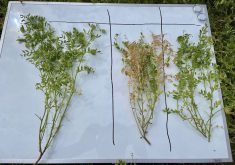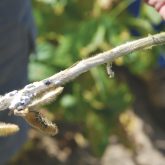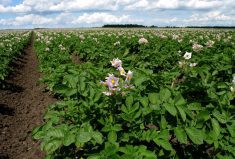The past five years have definitely been on the dry side in Manitoba’s pea-growing regions — an important fact to remember when considering the results of Manitoba Pulse and Soybean Growers’ (MPSG) 2021 on-farm pea fungicide trials.
That meant there was little disease pressure at the trial’s four locations (Roland, Swan River and two sites in the Dauphin region), and where disease was present, severity was low. Spraying was not economic at any of the sites in 2021.
Those results are in keeping with results from the previous four growing seasons, according to data released last fall in an online presentation by former MPSG agronomist Megan Bourns.
Read Also

Sensing the soil: Root cell research finds ‘stress hormone’
Research into how root cells react to soil stressors could help plants better adapt to changes in their climate.
Since 2017, 31 pea fungicide trials have been performed across Manitoba. In total, researchers have noted a significant yield increase following fungicide application just nine times out of 31, and economic yield increases only five times (in other words, yield boosts more than paid for the cost of fungicide application in five of 31 trials.) Only 16 per cent of the time did it “pay to spray” in terms of yield increases, according to Bourns’s presentation.
MPSG’s On-Farm Network runs the annual pea fungicide trials as part of a suite of trials designed to help farmers evaluate products and practices right on their farms.
Bourns said the on-farm pea fungicide trials aim to assess the economic and agronomic impacts of application. Each year, they look at the effects of disease pressure on yield and seed quality on peas left untreated, treated with a single application or treated with a double application.
These trials are more important than ever, as increased pea-processing capacity has helped double pea acreage in the province. The 2016-21 five-year average was 116,450 acres; 228,725 acres were planted in 2021.
The goal of the on-farm trials isn’t to make uniform recommendations for all of Manitoba’s growing regions but to guide management choices for farmers in a range of environments.
“The priority of the on-farm network is to answer questions about individual farmers’ fields first, then we apply those results to broader regions,” says Laura Schmidt, production specialist for MPSG. “It really does come down to that yield response to fungicide being field-specific, and only economical if the disease is actually there and conditions are right for disease development.”
Managing ascochyta blight
In Manitoba, ascochyta blight is the most widespread and economically damaging foliar disease of peas, and is present at some level in most fields each year. According to a fungicide decision worksheet developed by University of Alberta researchers and adapted for local use by MPSG, fungicides can also offer control of white mould, powdery mildew and rust, although these diseases are less frequent and their effects less severe.
Cool, wet conditions promote ascochyta; its impact will be more severe the earlier it sets in, and the faster it progresses up into the canopy.
Schmidt says symptoms first appear as small, purplish-brown “freckles” on leaves in the lower canopy, or as large, concentric ring-shaped lesions. Symptoms can look like bacterial blight, she warns, so producers should take care to correctly identify ascochyta before deploying a foliar fungicide.
The worksheet notes producers can begin scouting for ascochyta blight between the V10 and R2 stages. If symptoms are present, a fungicide should be applied at R2 when one flower is open on most plants in the field. A second application, using a different mode of action, can be considered 10 to 14 days later if symptoms have spread into the upper canopy and if conditions are right for disease, says Schmidt.
“Farmers are more likely to be interested in the question of single or double applications in years where it’s humid or wet. It might be necessary at times to control disease in wetter years. (But) if symptoms aren’t going up the canopy we’re not expecting to see losses.”
The fungicide decision worksheet is a significant tool in producers’ arsenal when weighing whether to spray, Schmidt adds. It helps producers create a total “score” of disease risk factors, including canopy closure, moisture levels, weather forecasts and symptoms. A fungicide application is recommended for a score over 65.
In 2021, the worksheet was used as the first step in the pea fungicide trials. Risk factor rankings ranged between 22 and 33 for the study’s four locations — well below a score of 65 — accurately predicting that application would represent an economic loss at each of those sites.
More pea fungicide trials are planned for the future and Schmidt says MPSG will continue to evaluate the worksheet. But she encourages producers to use it, particularly if they’re new to peas or in need of a refresher.
MPSG is always recruiting farmers to participate in its On-Farm Network trials, says Schmidt, and most return for a second or third year. “That means the farmers are getting value,” she says.
“The more farmers, the more areas we can reach.”
All On-Farm Network trial results and a guide to foliar fungicide decision-making in peas can both be found on the MPSG website.
















